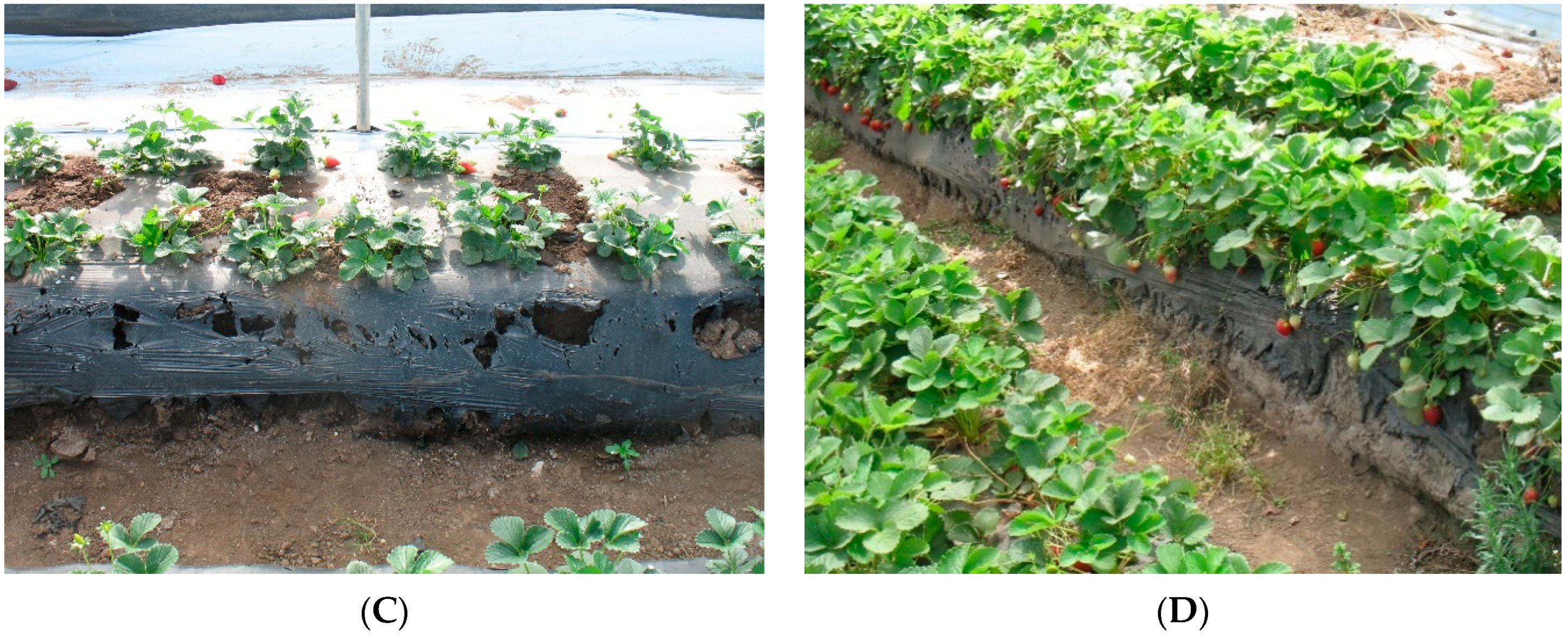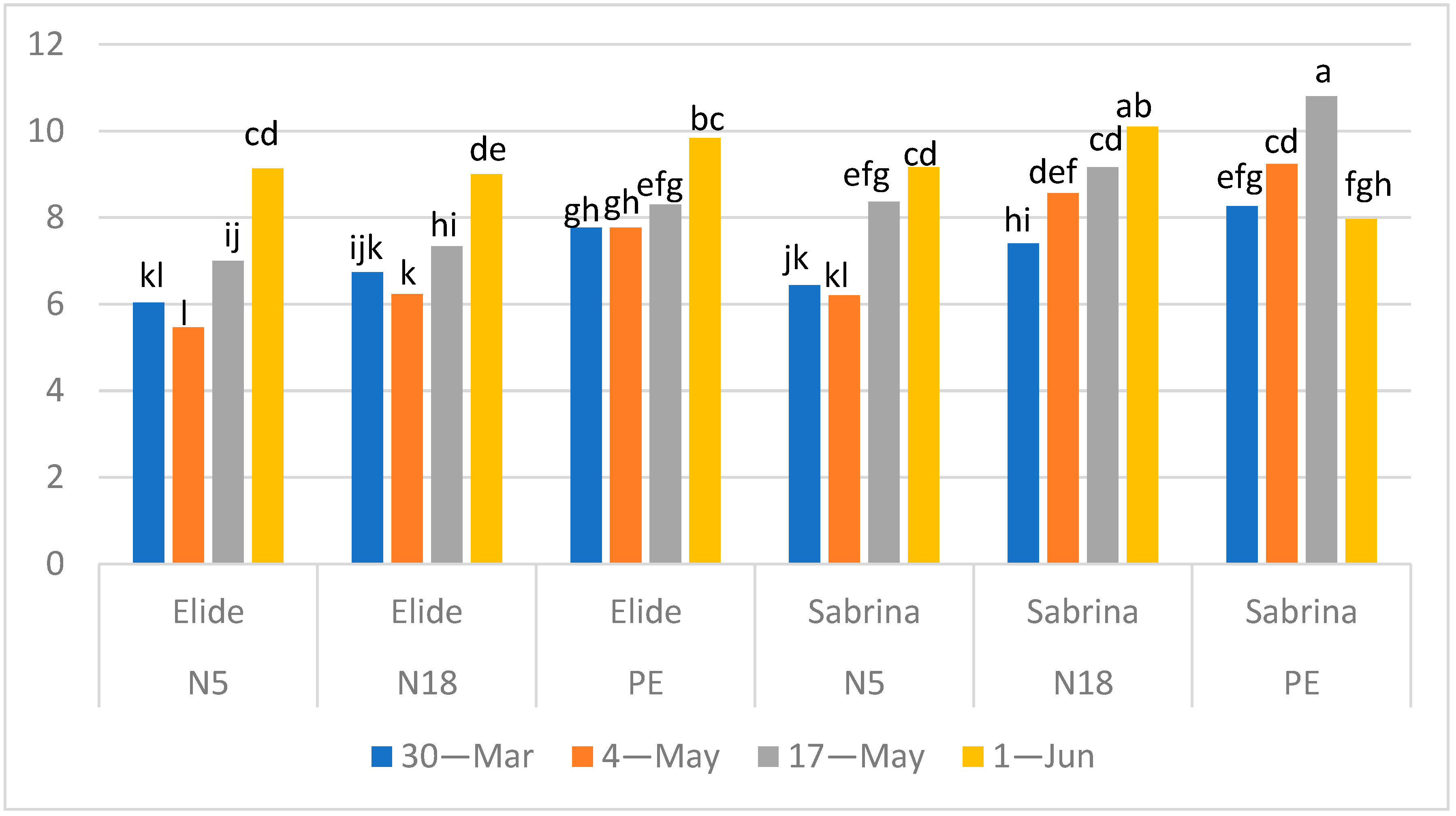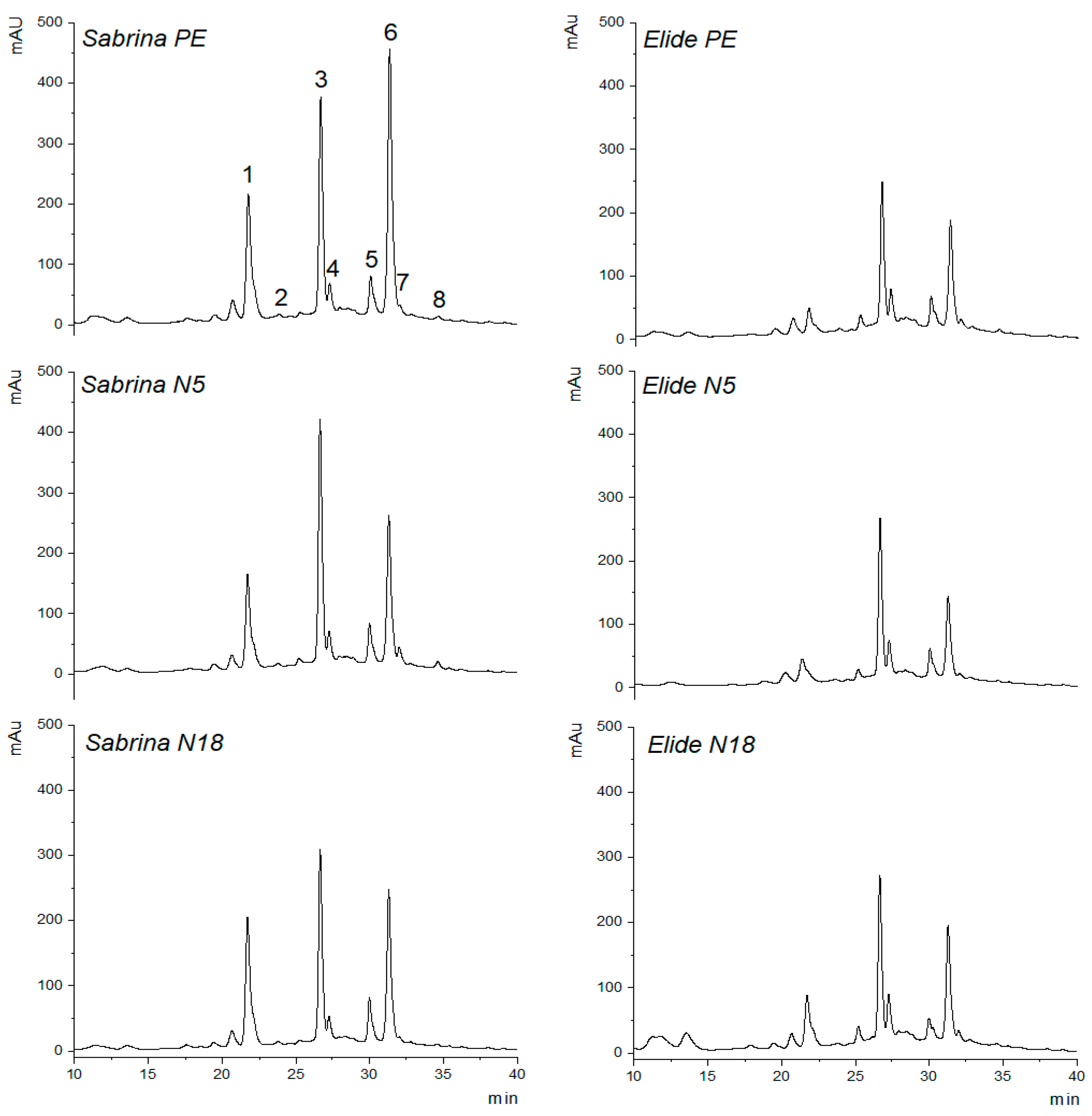New Mater-Bi, Biodegradable Mulching Film for Strawberry (Fragaria × Ananassa Duch.): Effects on Film Duration, Crop Yields, Qualitative, and Nutraceutical Traits of Fruits
Abstract
:1. Introduction
2. Results and Discussion
2.1. Mechanical Strength of Mulching Films and Yields of Strawberry
2.2. Quality of Fruits in Relation to Cultivars and Mulching Films during the Harvest Period
2.3. Phenolic Compounds in Elide and Sabrina cvs on Different Mulches in the Last Harvest
3. Materials and Methods
3.1. Location and Experimental Design
3.2. Agronomic Trial Management
3.3. Yields Assessment and Fruit Sampling
3.4. Qualitative and Nutraceutical Traits Analysis
3.5. Reversed Phase-High Performance Liquid Chromatographic-Diode Array Detector (RP-HPLC-DAD)—Semi-Quantitative Determination of Polyphenols
3.6. Statistical Analysis
4. Conclusions
Author Contributions
Funding
Institutional Review Board Statement
Informed Consent Statement
Acknowledgments
Conflicts of Interest
References
- Palha, M.G.; Campo, J.L.; Reis, L.; Curado, T.; Sousa, M.B.; Andrade, M.C.S. Solarization and chemical pre-planting soil disinfection effects on strawberry production. Acta Hortic. 2002, 842, 949–952. [Google Scholar]
- Van Kruistum, G.; den Belder, E. Towards a system of non-chemical flower hrips control in strawberry production. Acta Hortic. 2016, 1117, 133–138. [Google Scholar] [CrossRef]
- Steinmetz, Z.; Wollman, C.; Schaefer, M.; Buchmann, C.; David, J.; Troger, J.; Munoz, K.; Fror, O.; Schaumann, G.E. Plastic mulching in agriculture: Trading short term agronomic benefits for long term soil degradation? Sci. Total Environ. 2016, 550, 690–705. [Google Scholar] [CrossRef] [PubMed]
- Kasirajan, S.; Ngouajio, M. Polyetylene and biodegradable mulches for agricultural applications. A review. Agron. Sustain. Dev. 2012, 32, 501–529. [Google Scholar] [CrossRef]
- Menossi, M.; Cisneros, M.; Alvarez, V.A.; Casalonguè, C. Current and emerging biodegradable mulch films based on polysaccharide bio-composites. A review. Agron. Sustain. Dev. 2021, 41, 53. [Google Scholar] [CrossRef]
- Qi, Y.; Ossowicki, A.; Yanga, X.; Huerta Lwanga, E.; Dini-Andreote, F.; Geissen, V.; Garbeva, P. Effects of plastic mulch film residues on wheat rhizosphere and soil properties. J. Hazard. Mater. 2020, 387, 121711. [Google Scholar] [CrossRef]
- Goldberger, J.R.; DeVetter, L.W.; Dentzman, E. Polyethylene and biodegradable plastic mulchs for strawberry production in the United States: Experiences and opinions of growers in three regions. HortTechnology 2019, 29, 619–628. [Google Scholar] [CrossRef]
- Bilck, A.P.; Grossmann, M.V.E.; Yamashita, F. Biodegradable mulch films for strawberry production. Polym. Test. 2010, 29, 471–476. [Google Scholar] [CrossRef]
- DeVetter, L.W.; Zhang, H.; Ghimire, S.; Watkinson, S.; Miles, C.A. Plastic biodegradable mulches reduce weeds and promote crop growth in day-neutral strawberry in Western Washington. HortScience 2017, 42, 1700–1706. [Google Scholar] [CrossRef] [Green Version]
- Costa, R.; Saraiva, A.; Carvalho, L.; Duarte, E. The use of biodegradable mulch films on strawberry crop in Portugal. Sci. Hortic. 2014, 173, 65–70. [Google Scholar] [CrossRef]
- Morra, L.; Bilotto, M.; Cerrato, D.; Coppola, R.; Leone, V.; Mignoli, E.; Pasquariello, M.S.; Petriccione, M.; Cozzolino, E. The Mater-Bi biodegradable film for strawberry (Fragaria × Ananassa Duch.) mulching: Effects on fruit yield and quality. Ital. J. Agron. 2016, 11, 203–206. [Google Scholar] [CrossRef] [Green Version]
- EN-17033. Available online: https://www.en-standard.eu/csn-en-17033-plastics-biodegradable-mulch-films-for-use-in-agriculture-and-horticulture-requirements-and-test-methods/ (accessed on 18 May 2022).
- Miller, K.; Feucht, W.; Schmid, M. Bioactive compounds of strawberry and blueberry and their potential health effects based on human intervention studies: A brief overview. Nutrients 2019, 11, 1510. [Google Scholar] [CrossRef] [PubMed] [Green Version]
- Mustafa, A.M.; Angeloni, S.; Abouelenein, D.; Acquaticci, L.; Xiao, J.; Sagratini, G.; Maggi, F.; Vittori, S.; Caprioli, G. A new HPLC-MS/MS method for the simultaneous determination of 36 polyphenols in blueberry, strawberry and their commercial products and determination of antioxidant activity. Food Chem. 2022, 367, 130743. [Google Scholar] [CrossRef] [PubMed]
- CREA-Centro Ricerca Politica e Bioeconomia. Annuario dell’Agricoltura Italiana 2020; CREA: Roma, Italy, 2021; Volume 74, p. 588. [Google Scholar]
- Andrade, C.S.; Palha, M.G.; Duarte, E. Biodegradable mulchfilms performance for autumn-winter strawberry production. J. Berry Res. 2014, 4, 193–202. [Google Scholar] [CrossRef] [Green Version]
- Giordano, M.; Amoroso, C.G.; El-Nakhel, C.; Rouphael, Y.; De Pascale, S.; Cirillo, C. An appraisal of biodegradable mulch films with respect to strawberry crop performance and fruit quality. Horticulturae 2020, 6, 48. [Google Scholar] [CrossRef]
- Cecatto, A.P.; Calvete, E.O.; Nienow, A.A.; Costa RC da Mendonça, H.F.C.; Pazzinato, A.C. Culture systems in the production and quality of strawberry cultivars. Acta Sci. Agron. 2013, 35. [Google Scholar] [CrossRef] [Green Version]
- Mendes da Silva, T.; Giuggioli, N.R.; Peano, C. Modelling strawberry quality in a longitudinal study under the marketing concept of branding. Heliyon 2021, 7, e06165. [Google Scholar] [CrossRef]
- Cervantes, L.; Ariza, M.T.; Miranda, L.; Lozano, D.; Medina, J.J.; Soria, C.; Martínez-Ferri, E. Stability of fruit quality traits of different strawberry varieties under variable environmental conditions. Agronomy 2020, 10, 1242. [Google Scholar] [CrossRef]
- Zhang, Y.; Yang, M.; Hou, G.; Zhang, Y.; Chen, Q.; Lin, Y.; Li, M.; Wang, Y.; He, W.; Wang, X.; et al. Effect of Genotype and Harvest Date on Fruit Quality, Bioactive Compounds, and Antioxidant Capacity of Strawberry. Horticulturae 2022, 8, 348. [Google Scholar] [CrossRef]
- Del Pozo-Insfran, D.; Duncan, C.E.; Yu, K.C.; Talcott, S.T.; Chandler, C.K. Polyphenolics, ascorbic acid, and soluble solids concentrations of strawberry cultivars and selections grown in a winter annual hill production system. J. Am. Soc. Hortic. Sci. 2006, 131, 89–96. [Google Scholar] [CrossRef] [Green Version]
- Tulipani, S.; Marzaban, G.; Herndl, A.; Laimer, M.; Mezzetti, B.; Battino, M. Influence of environmental and genetic factors on health-related compounds in strawberry. Food Chem. 2011, 124, 906–913. [Google Scholar] [CrossRef]
- Palmieri, L.; Masuero, D.; Martinatti, P.; Baratto, G.; Martens, S.; Vrhovsek, U. Genotype-by-environment effect on bioactive compounds in strawberry (Fragaria x ananassa Duch.). Sci. Food Agric. 2017, 97, 4180–4189. [Google Scholar] [CrossRef] [PubMed]
- Pradas, I.; Medina, J.J.; Ortiz, V.; Moreno-Rojas, J.M. ‘Fuentepina’ and ‘Amiga’, two new strawberry cultivars: Evaluation of genotype, ripening and seasonal effects on quality characteristics and health-promoting compounds. J. Berry Res. 2015, 5, 157–171. [Google Scholar] [CrossRef] [Green Version]
- Wang, S.Y.; Zheng, W. Effect of plant growth temperature on antioxidant capacity in strawberry. J. Agric. Food Chem. 2001, 49, 4977–4982. [Google Scholar] [CrossRef] [PubMed]
- Fan, L.; Dubè, C.; Fang, C.; Roussel, D.; Charles, M.T.; Desjardin, Y.; Khanizadeh, S. Effect of production systems on phenolic composition and oxygen radical absorbance capacity of ‘Orleans’ strawberry. LWT Food Sci. Technol. 2012, 45, 241–245. [Google Scholar] [CrossRef]
- Zeliou, K.; Papasotiropoulos, V.; Manoussopoulos, Y.; Lamari, F.N. Physical and chemical quality characteristics and antioxidant properties of strawberry cultivars (Fragaria × ananassa Duch.) in Greece: Assessment of their sensory impact. J. Sci. Food Agric. 2018, 98, 4065–4073. [Google Scholar] [CrossRef]
- Petriccione, M.; Pasquariello, M.S.; Mastrobuoni, F.; Zampella, L.; Patre, D.D.; Scortichini, M. Influence of a chitosan coating on the quality and nutraceutical traits of loquat fruit during postharvest life. Sci. Hortic. 2015, 197, 287–296. [Google Scholar] [CrossRef]
- Petriccione, M.; Mastrobuoni, F.; Pasquariello, M.S.; Zampella, L.; Nobis, E.; Capriolo, G.; Scortichini., M. Effect of Chitosan Coating on the Postharvest Quality and Antioxidant Enzyme System Response of Strawberry Fruit during Cold Storage. Foods 2015, 4, 501–523. [Google Scholar] [CrossRef] [Green Version]
- Cardeñosa, V.; Girones-Vilaplana, A.; Muriel, J.L.; Moreno, D.A.; Moreno-Rojas, J.M. Influence of genotype, cultivation system and irrigation regime on antioxidant capacity and selected phenolics of blueberries (Vaccinium corymbosum L.). Food Chem. 2016, 202, 276–283. [Google Scholar] [CrossRef]
- Shiukhy, S.; Raeini-Sarjaz, M.; Chalavi, V. Colored plastic mulch microclimates affect strawberry fruit yield and Quality. Int. J. Biometeorol. 2015, 59, 1061–1066. [Google Scholar] [CrossRef]
- Lalk, G.T.; Bi, G.; Zhang, Q.; Harkess, R.L.; Li, T. High tunnel production of strawberries using black and red plastic mulches. Horticulturae 2020, 6, 73. [Google Scholar] [CrossRef]
- Cozzolino, R.; Pace, B.; Palumbo, M.; Laurino, C.; Picariello, G.; Siano, F.; De Giulio, B.; Pelosi, S.; Cefola, M. Profiles of Volatile and Phenolic Compounds as Markers of Ripening Stage in Candonga Strawberries. Foods 2021, 10, 3102. [Google Scholar] [CrossRef]
- Yeh, S.Y.; Huang, F.C.; Hoffmann, T.; Mayershofer, M.; Schwab, W. FaPOD27 functions in the metabolism of polyphenols in strawberry fruit (Fragaria sp.). Front. Plant Sci. 2014, 5, 518. [Google Scholar] [CrossRef]
- Adiletta, G.; Liguori, L.; Albanese, D.; Russo, P.; Di Matteo, M.; Crescitelli, A. Soft-Seeded pomegranate (Punica granatum L.) varieties: Preliminary characterization and quality changes of minimally processed arils during storage. Food Bioprocess Technol. 2017, 10, 1631–1641. [Google Scholar] [CrossRef]
- Adiletta, G.; Petriccione, M.; Liguori, L.; Pizzolongo, F.; Romano, R.; Di Matteo, M. Study of pomological traits and physico-chemical quality of pomegranate (Punica granatum L.) genotypes grown in Italy. Eur. Food Res. Technol. 2018, 244, 1427–1438. [Google Scholar] [CrossRef]
- Magri, A.; Adiletta, G.; Petriccione, M. Evaluation of Antioxidant Systems and Ascorbate Glutathione Cycle in Feijoa Edible Flowers at Different Flowering Stages. Foods 2020, 9, 95. [Google Scholar] [CrossRef] [PubMed] [Green Version]
- Adiletta, G.; Di Matteo, M.; Albanese, D.; Farina, V.; Cinquanta, L.; Corona, O.; Magri, A.; Petriccione, M. Changes in physico-chemical traits and enzymes oxidative system during cold storage of ‘Formosa ‘papaya fresh cut fruits grown in the Mediterranean area (Sicily). Ital. J. Food Sci. 2020, 32. [Google Scholar] [CrossRef]
- Cozzolino, R.; De Giulio, B.; Petriccione, M.; Martignetti, A.; Malorni, L.; Zampella, L.; Laurino, C.; Pellicano, M.P. Comparative analysis of volatile metabolites, quality and sensory attributes of Actinidia chinensis fruit. Food Chem. 2020, 316, 126340. [Google Scholar] [CrossRef]








| Mean Fruit Weight (g) | Marketable Yield per Plant (g) | Non-Marketable Yield per Plant (g) | Total Marketable Yield | ||||
|---|---|---|---|---|---|---|---|
| Cultivar | Extra | First | Extra | First | Total | (t ha−1) | |
| Sabrina | 29.4 | 17.1 | 416.2 | 211.3 | 627.5 | 22.6 | 41.4 |
| Elide | 29.6 | 16.5 | 451.3 | 194.3 | 645.6 | 14.7 | 42.0 |
| p | n.s. | n.s. | n.s. | n.s. | n.s. | ** | n.s. |
| Mulch | |||||||
| MB N5 | 29.5 ab | 16.3 | 460.2 | 217.1 | 677.3 | 19.6 | 44.7 |
| MB N18 | 30.6 a | 17.7 | 451.8 | 193.0 | 644.8 | 17.7 | 42.5 |
| PE | 28.5 b | 16.3 | 389.3 | 198.4 | 587.7 | 18.6 | 37.9 |
| p | ** | n.s. | n.s. | n.s. | n.s. | n.s. | n.s. |
| Mulch × Cultivar | |||||||
| p | ** | * | n.s. | n.s. | n.s. | n.s. | n.s. |
| TSS (°Brix) | Ascorbic Acid | Polyphenols | Anthocyanins | Flavonoids | Antioxidant Activity | |
|---|---|---|---|---|---|---|
| (mg 100 g−1 f.w.) | (mg GAE 100g−1 f.w.) | (mg CGE 100 g−1 f.w.) | (mg CAE 100 g−1 f.w.) | (μmol TE g−1 f.w.) | ||
| Cultivar | *** | n.s. | *** | *** | * | *** |
| Mulch | *** | n.s. | *** | *** | n.s. | n.s. |
| Time | *** | *** | *** | *** | *** | *** |
| Mulch× Cv | *** | * | * | *** | ** | n.s. |
| Mulch × Time | *** | ** | *** | *** | *** | *** |
| Cv × Time | *** | *** | *** | *** | *** | *** |
| Mulch× Cv × Time | *** | n.s. | *** | *** | *** | *** |
| MULCH N5 | °Brix | Polyphenols | Antioxidant Activity | Anthocyanins |
|---|---|---|---|---|
| °Brix | ||||
| Polyphenols | ||||
| Antiox. Activ. | ||||
| Anthocyanins | −0.41 * | 0.56 ** | ||
| Ascorbic Ac. | −0.76 *** | |||
| Flavonoids | 0.53 ** | |||
| MULCH N18 | ||||
| °Brix | ||||
| Polyphenols | ||||
| Antiox. Activ. | −0.45 * | |||
| Anthocyanins | 0.48 ** | |||
| Ascorbic Ac. | −0.76 *** | |||
| Flavonoids | 0.50 ** | |||
| PE | ||||
| °Brix | ||||
| Polyphenols | ||||
| Antiox. Activ. | ||||
| Anthocyanins | 0.45 * | |||
| Ascorbic Ac. | −0.46 * | −0.49 ** | ||
| Flavonoids | 0.46 ** | −0.53 ** |
| Polyphenols | Code | PE | N5 | N18 | p | |||
|---|---|---|---|---|---|---|---|---|
| p-coumaryl hexoside | P1 | 47.5 ± 0.4 | a | 34.5 ± 0.2 | c | 43.1 ± 0.3 | b | *** |
| cyanidin-3-O-glucoside | P2 | 0.4 ± 0.0 | b | 0.7 ± 0.0 | a | 0.2 ± 0.0 | c | *** |
| pelargonidin 3-O-glucoside | P3 | 20.7 ± 0.2 | b | 23.9 ± 0.2 | a | 17.0 ± 0.0 | c | *** |
| pelargonidin 3-rutinoside | P4 | 2.3 ± 0.0 | a | 2.2 ± 0.1 | a | 1.8 ± 0.0 | b | *** |
| quercetin-3-O-glucoside | P5 | 1.8 ± 0.1 | a | 1.8 ± 0.1 | a | 1.1 ± 0.0 | b | *** |
| kaempferol-3-O-glucoside | P6 | 1.2 ± 0.0 | a | 1.3 ± 0.1 | a | 0.7 ± 0.1 | b | *** |
| quercetin-3-O-glucuronide | P7 | 2.7 ± 0.1 | b | 11.2 ± 0.2 | a | 1.2 ± 0.1 | c | *** |
| kaempferol-3-O-glucuronide | P8 | 2.8 ± 0.1 | b | 4.9 ± 0.1 | a | 1.5 ± 0.0 | c | *** |
| Polyphenols | Code | PE | N5 | N18 | p | |||
|---|---|---|---|---|---|---|---|---|
| p-coumaryl hexoside | P1 | 8.5 ± 0.2 | c | 10.8 ± 0.1 | b | 17.4 ± 0.1 | a | *** |
| cyanidin-3-O-glucoside | P2 | 1.4 ± 0.0 | b | 1.1 ± 0.1 | c | 1.6 ± 0.1 | a | *** |
| pelargonidin 3-O-glucoside | P3 | 13.2 ± 0.1 | b | 14.4 ± 0.1 | a | 14.5 ± 0.3 | a | *** |
| pelargonidin 3-rutinoside | P4 | 1.7 ± 0.0 | c | 2.1 ± 0.1 | a | 2.0 ± 0.1 | b | *** |
| quercetin-3-O-glucoside | P5 | 2.5 ± 0.1 | a | 1.8 ± 0.1 | b | 2.4 ± 0.2 | a | *** |
| kaempferol-3-O-glucoside | P6 | 1.8 ± 0.0 | b | 1.3 ± 0.1 | c | 2.1 ± 0.2 | a | *** |
| quercetin-3-O-glucuronide | P7 | 4.8 ± 0.0 | b | 2.4 ± 0.2 | c | 5.5 ± 0.3 | a | *** |
| kaempferol-3-O-glucuronide | P8 | 2.3 ± 0.0 | a | 1.3 ± 0.1 | c | 1.7 ± 0.1 | b | *** |
Publisher’s Note: MDPI stays neutral with regard to jurisdictional claims in published maps and institutional affiliations. |
© 2022 by the authors. Licensee MDPI, Basel, Switzerland. This article is an open access article distributed under the terms and conditions of the Creative Commons Attribution (CC BY) license (https://creativecommons.org/licenses/by/4.0/).
Share and Cite
Morra, L.; Bilotto, M.; Mignoli, E.; Sicignano, M.; Magri, A.; Cice, D.; Cozzolino, R.; Malorni, L.; Siano, F.; Picariello, G.; et al. New Mater-Bi, Biodegradable Mulching Film for Strawberry (Fragaria × Ananassa Duch.): Effects on Film Duration, Crop Yields, Qualitative, and Nutraceutical Traits of Fruits. Plants 2022, 11, 1726. https://doi.org/10.3390/plants11131726
Morra L, Bilotto M, Mignoli E, Sicignano M, Magri A, Cice D, Cozzolino R, Malorni L, Siano F, Picariello G, et al. New Mater-Bi, Biodegradable Mulching Film for Strawberry (Fragaria × Ananassa Duch.): Effects on Film Duration, Crop Yields, Qualitative, and Nutraceutical Traits of Fruits. Plants. 2022; 11(13):1726. https://doi.org/10.3390/plants11131726
Chicago/Turabian StyleMorra, Luigi, Maurizio Bilotto, Emiliana Mignoli, Mariarosaria Sicignano, Anna Magri, Danilo Cice, Rosaria Cozzolino, Livia Malorni, Francesco Siano, Gianluca Picariello, and et al. 2022. "New Mater-Bi, Biodegradable Mulching Film for Strawberry (Fragaria × Ananassa Duch.): Effects on Film Duration, Crop Yields, Qualitative, and Nutraceutical Traits of Fruits" Plants 11, no. 13: 1726. https://doi.org/10.3390/plants11131726
APA StyleMorra, L., Bilotto, M., Mignoli, E., Sicignano, M., Magri, A., Cice, D., Cozzolino, R., Malorni, L., Siano, F., Picariello, G., Guerrini, S., & Petriccione, M. (2022). New Mater-Bi, Biodegradable Mulching Film for Strawberry (Fragaria × Ananassa Duch.): Effects on Film Duration, Crop Yields, Qualitative, and Nutraceutical Traits of Fruits. Plants, 11(13), 1726. https://doi.org/10.3390/plants11131726










